oil temperature PONTIAC BONNEVILLE 1995 Owners Manual
[x] Cancel search | Manufacturer: PONTIAC, Model Year: 1995, Model line: BONNEVILLE, Model: PONTIAC BONNEVILLE 1995Pages: 338, PDF Size: 16.19 MB
Page 108 of 338
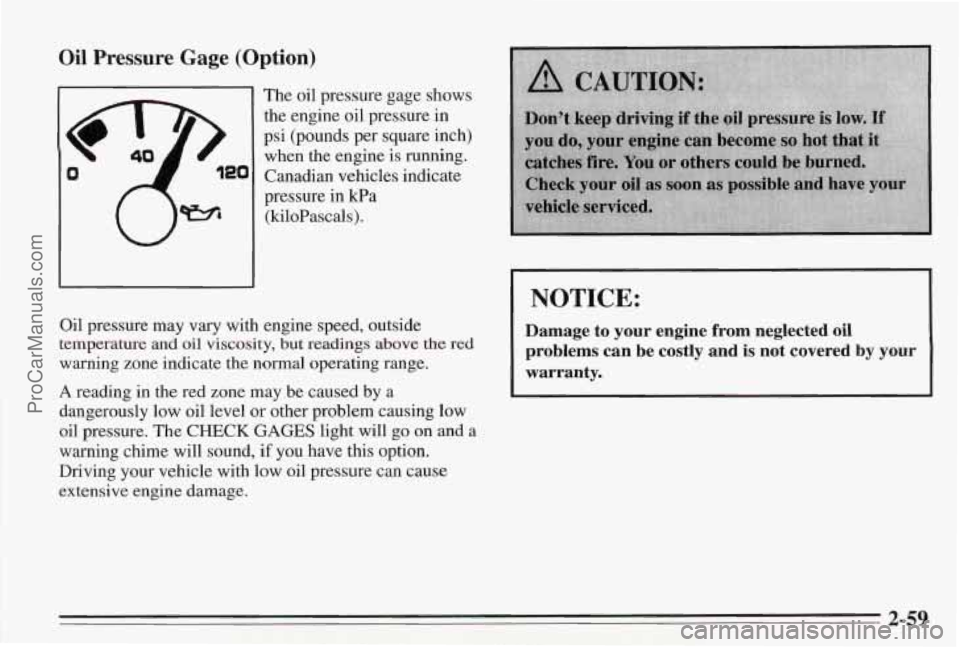
Oil Pressure Gage (Option)
The oil pressure gage shows
the engine
oil pressure in
psi (pounds per square inch)
when the engine is running.
Canadian vehicles indicate
pressure in Ea
(kiloPascals).
NOTICE:
Oil pressure may vary with engine speed, outside
temperature and oil viscosity,
but readings above the red
warning zone indicate the normal operating range.
A reading in the red zone may be caused by a
dangerously
low oil level or other problem causing low
oil pressure. The
CHECK GAGES light will go on and a
warning chime will sound, if you have this option.
Driving your vehicle with low oil pressure can cause
extensive engine damage.
Damage to your engine from neglected oil
problems can be costly and is not covered by your
warranty.
2-59
ProCarManuals.com
Page 109 of 338
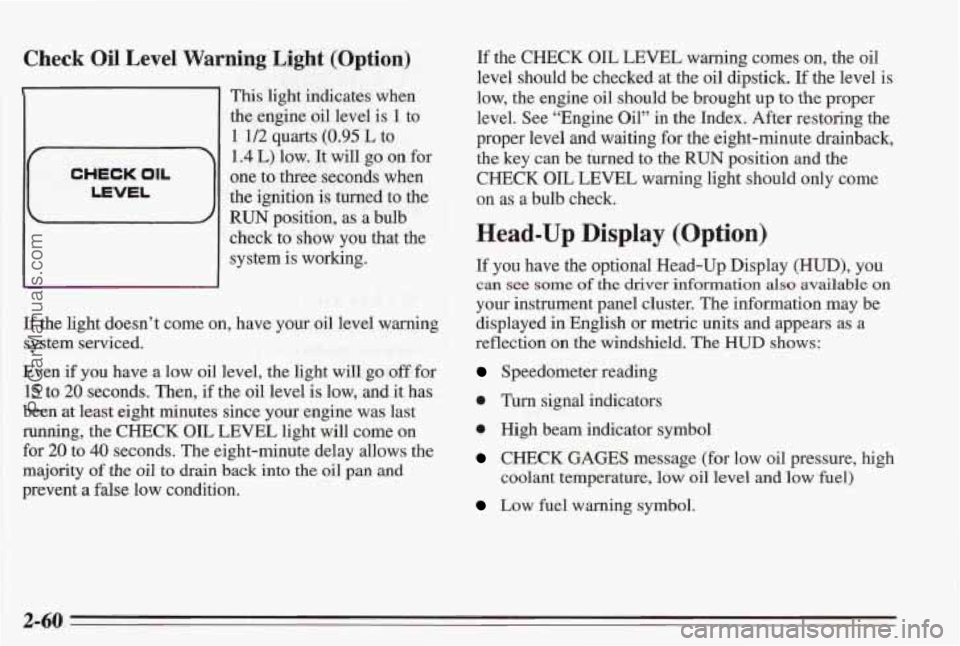
Check Oil Level Warning Light (Option)
1
CHECK OIL
LEVEL
1 This light indicates when
the engine oil level is
1 to
1 1/2 quarts (0.95 L to
1.4 L) low. It will go on for
one to three seconds when
the ignition is turned to the
RUN position, as a bulb
check to show
you that the
system is working.
If the light doesn’t come on, have your oil level warning
system serviced.
Even if
you have a low oil level, the light will go off for
15 to 20 seconds. Then, if the oil level is low, and it has
been at least eight minutes since your engine was last
running, the CHECK OIL LEVEL light will come on
for 20 to
40 seconds. The eight-minute delay allows the
majority of the
oil to drain back into the oil pan and
prevent
a false low condition. If the
CHECK OIL LEVEL
warning comes on, the oil
level should be checked at the oil dipstick. If the level is
low, the engine oil should be brought up
to the proper
level. See “Engine Oil” in the Index. After restoring the
proper level and
waiting for the eight-minute drainback,
the key can be turned to the
RUN position and the
CHECK OIL LEVEL warning light should only come
on
as a bulb check.
Head-Up Display (Option)
If you have the optional Head-Up Display (HUD), you
can see some of the driver information also available on
your instrument panel cluster. The information may be
displayed in English or metric units and appears as
a
reflection on the windshield. The HUD shows:
Speedometer reading
0 Turn signal indicators
e High beam indicator symbol
CHECK GAGES message (for low oil pressure, high
coolant temperature, low oil level and
low fuel)
Low fuel warning symbol.
2-60
ProCarManuals.com
Page 113 of 338
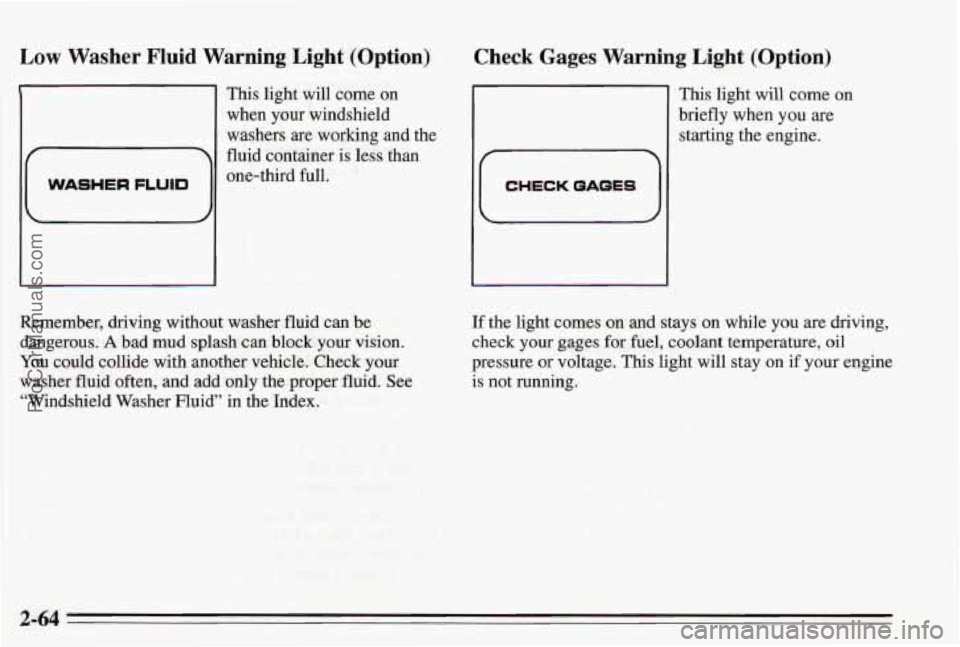
Low Washer Fluid Warning Light (Option)
E
WASHER FLUID
This light will come on
when your windshield
washers
are working and the
fluid container is less than
one-third full.
Check Gages Warning Light (Option)
11 This light will come on
brieflywhen you are
starting the engine.
CHECK QAQES
Remember, driving without washer fluid can be
dangerous.
A bad mud splash cm block your vision.
You could collide with another vehicle. Check your
washer fluid often, and add only the proper fluid. See
“Windshield Washer Fluid” in the Index.
If the light comes on and stays on while you are driving,
check
your gages for fuel, coolant temperature, oil
pressure or voltage. This light will stay on if your engine
is not running.
2-64
ProCarManuals.com
Page 116 of 338
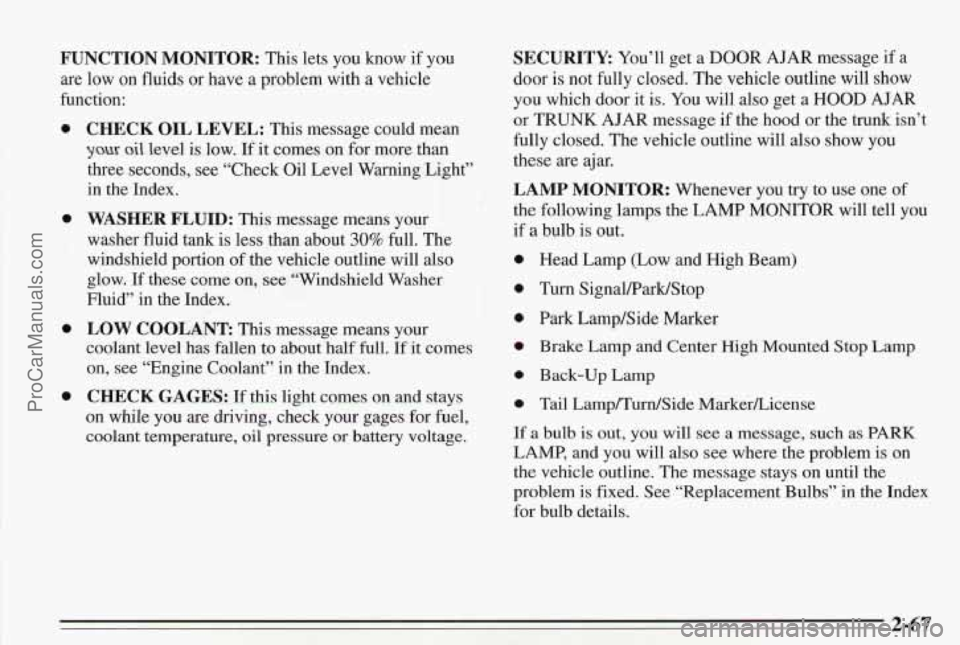
FUNCTION MONITOR: This lets you know if you
are low on fluids or have a problem with a vehicle
function:
0
0
0
0
CHECK OIL LEVEL: This message could mean
you oil level is low. If it comes on for more than
three seconds, see “Check Oil Level Warning Light”
in the Index.
WASHER FLUID: This message means your
washer fluid tank is less than about
30% full. The
windshield portion of the vehicle outline will also
glow.
If these come on, see “Windshield Washer
Fluid” in the Index.
LOW COOLANT This message means your
coolant level has fallen
to about half full. If it comes
on, see “Engine Coolant”
in the Index.
CHECK GAGES: If this light comes on and stays
on while you are driving, check your gages for fuel,
coolant temperature,
oil pressure or battery voltage.
SECURITY: You’ll get a DOOR AJAR message if a
door
is not fully closed. The vehicle outline will show
you which door it is.
You will also get a HOOD AJAR
or TRUNK AJAR message if the hood or the trunk isn’t
fully closed. The vehicle outline will also show you
these are ajar.
LAMP MONITOR: Whenever you try to use one of
the following lamps the LAMP MONITOR will tell you
if
a bulb is out.
Head Lamp (Low and High Beam)
Turn SignaWarWStop
Park Lamp/Side Marker
Brake Lamp and Center
High Mounted Stop Lamp
Back-up Lamp
Tail Lamp/Turn/Side MarkerLicense
If
a bulb is out, you will see a message, such as PARK
LAMP, and you will also see where the problem is on
the vehicle outline. The message stays on until the
problem is fixed. See “Replacement Bulbs” in the Index
for bulb details.
2-67
ProCarManuals.com
Page 227 of 338
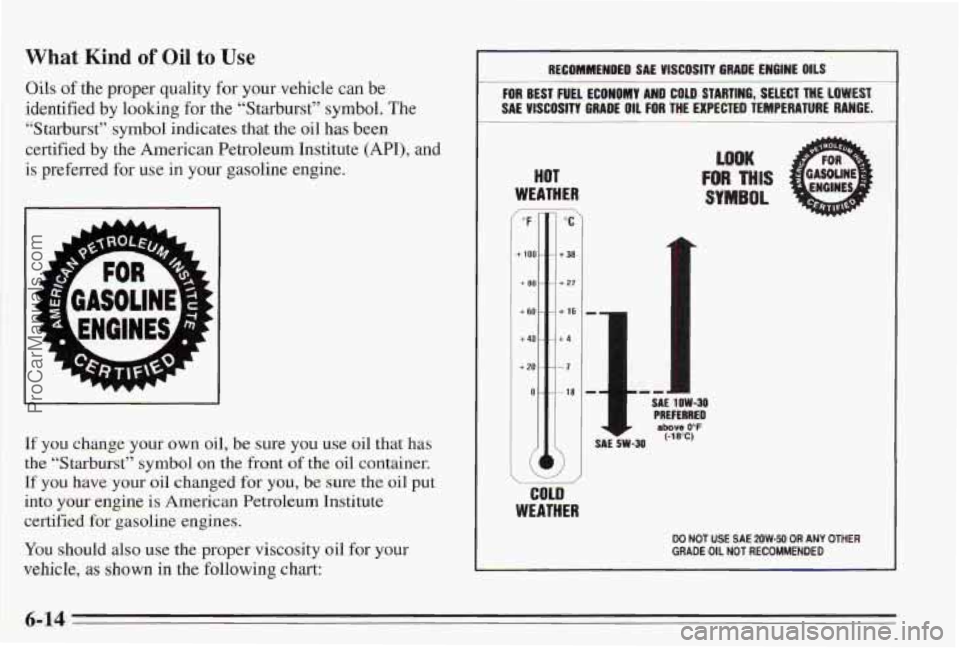
What Kind of Oil to Use
Oils of the proper quality for your vehicle can be
identified by looking for the “Starburst” symbol. The
“Starburst” symbol indicates that
the oil has been
certified by the American Petroleum Institute (API), and
is preferred for use in your gasoline engine.
**
L
t
t L
4
If you change your own oil, be sure you use oil that has
the “Starburst” symbol on the front of the oil container.
If you have your oil changed for you, be sure the oil put
into your engine is American Petroleum Institute
certified for gasoline engines.
You should also use
the proper viscosity oil for your
vehicle,
as shown in the following chart:
~
RECOMMENDED SAE VISCOSITY GRADE ENGINE OILS
FOR BEST FUEL ECONOMY AND COLD STARTINB, SELECT THE LOWEST
SAL VISCOSITY GRADE OIL FOR THE EXPECTED TEMPERATURE RANGE.
HOT
WEATHER 7
“C
+ 38
+ 27
+ 16
t4
-1
- 18
M
LOOK
FOR THIS 1
SYMBOL
I E ERRRED 1OW-30
mve 0°F (-1 8°C)
WEATHER
DO NOT USE SAE 2OW.50 OR ANY OTHER GRADE OIL NOT RECOMMENDED
6-14
ProCarManuals.com
Page 228 of 338
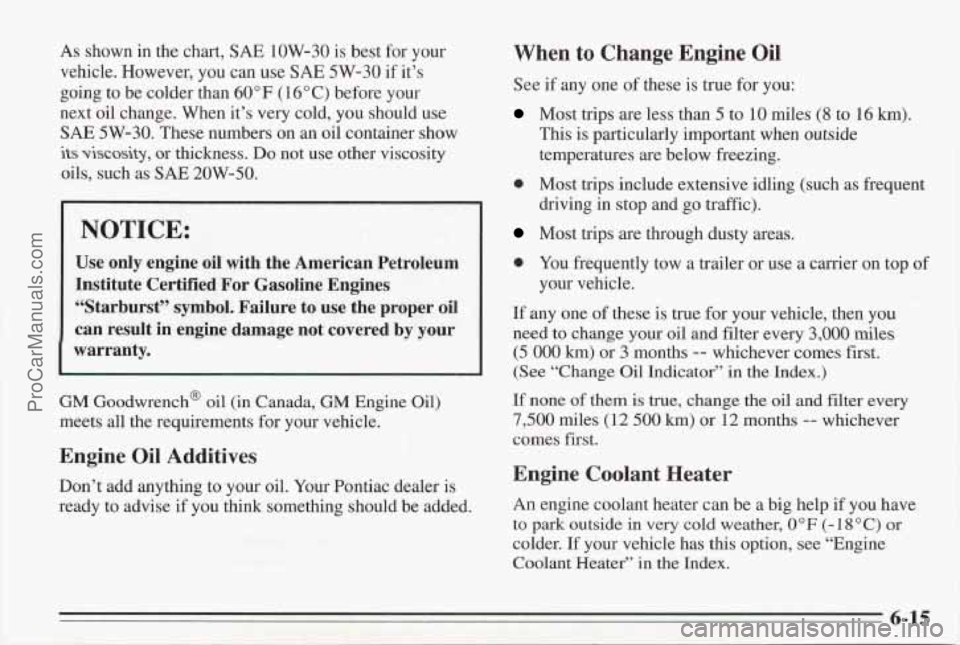
As shown in the chart, SAE 1OW-30 is best for your
vehicle. However, you can use
SAE 5W-30 if it’s
going to be colder than
60” F ( 16” C) before your
next oil change. When it’s very cold,
you should use
SAE 5W-30. These numbers on an oil container show
its viscosity, or thickness. Do not use other viscosity
oils, such as
SAE 20W-50.
NOTICE:
Use only engine oil with the American Petroleum
Institute Certified For Gasoline Engines
“Starburst” symbol. Failure to use the proper
oil
can result in engine damage not covered by your
warranty.
GM Goodwrench@ oil (in Canada, GM Engine Oil)
meets all the requirements for your vehicle.
Engine Oil Additives
Don’t add anything to your oil. Your Pontiac dealer is
ready to advise
if you think something should be added.
When to Change Engine Oil
See if any one of these is true for you:
Most trips are less than 5 to 10 miles (8 to 16 km).
This is particularly important when outside
temperatures are below freezing.
0 Most trips include extensive idling (such as frequent
driving in stop and go traffic).
Most trips are through dusty areas.
@ You frequently tow a trailer or use a carrier on top of
If any one of these is true for your vehicle, then you
need to change your oil and filter every
3,000 miles
(5 000 km) or 3 months -- whichever comes first.
(See “Change Oil Indicator” in
the Index.)
If none of them is true, change the oil and filter every
7,500 miles (12 500 km) or 12 months -- whichever
comes first. your vehicle.
Engine Coolant Heater
An
engine coolant heater can be a big help if you have
to park outside in very cold
weather, 0°F (- 18°C) or
colder. If your vehicle has this option, see “Engine
Coolant Heater” in the Index.
6-15
ProCarManuals.com
Page 233 of 338
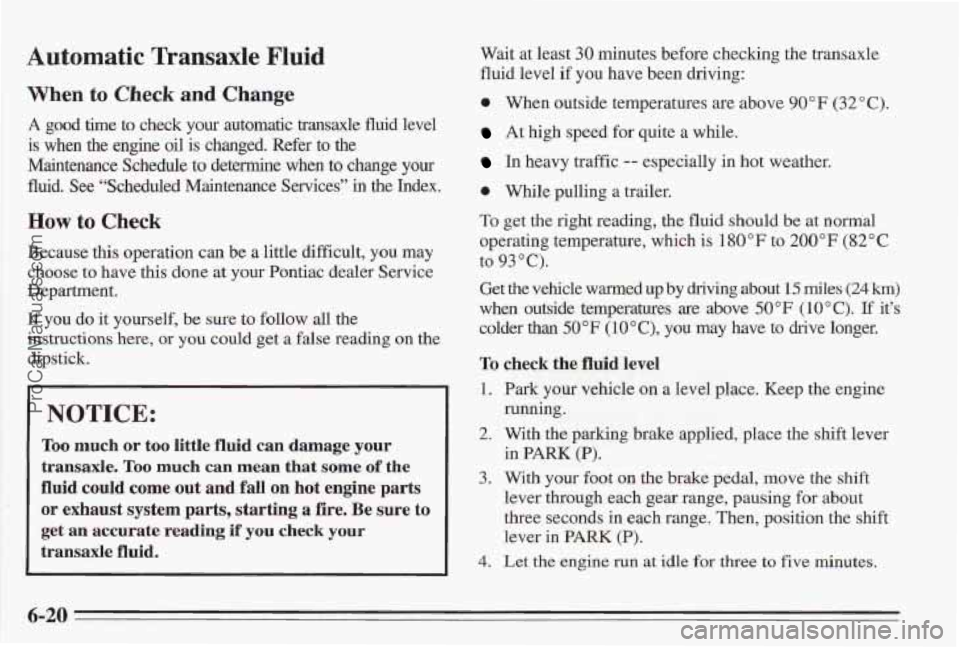
Automatic Transaxle Fluid
When to Check and Change
A good time to check your automatic transaxle fluid level
is when the engine oil is changed. Refer to the
Maintenance Schedule to detemrrine when to change your
fluid. See "Scheduled Maintenance Services" in the Index.
How to Check
Because this operation can be a little difficult, you may
choose
to have this done at your Pontiac dealer Service
Department.
If you do it yourself, be sure to follow all the
instructions here, or you could get a false reading on the
dipstick.
NOTICE:
Too much or too little fluid can damage your
transaxle.
Too much can mean that some of the
fluid could come out and fall
on hot engine parts
or exhaust system parts, starting a fire. Be sure to
get an accurate reading if you check your
transaxle fluid.
~~~
Wait at least 30 minutes before checking the transaxle
fluid level
if you have been driving:
0 When outside temperatures are above 90" F (32°C).
At high speed for quite a while.
In heavy traffic - especially in hot weather.
0 While pulling a trailer.
To get the right reading, the fluid should be at normal
operating temperature, which is
180 "F to 200°F (82" C
to 93 "C).
Get the vehicle warmed up by driving about €5 des (24 km)
when outside temperatures are above 50°F (10°C). If it's
colder
than 50°F (lO"C), you may have to drive longer.
To check the fluid level
1. Park your vehicle on a level place. Keep the engine
running.
2. With the parking brake applied, place the shift lever
in PARK (P).
3. With your foot on the brake pedal, move the shift
lever through each gear range, pausing for about
three seconds
in each range. Then, position the shift
lever in PARK (P).
4. Let the engine run at idle for three to five minutes.
6-20
ProCarManuals.com
Page 235 of 338
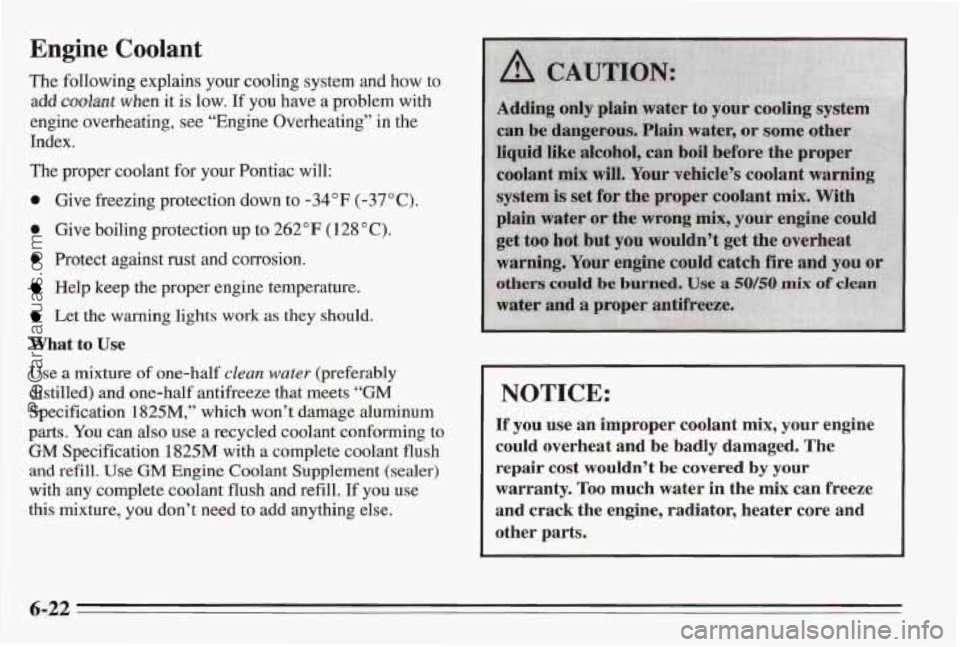
Engine Coolant
The following explains your cooling system and how to
add
coolant when it is low. If you have a problem with
engine overheating, see “Engine Overheating” in the
Index.
The proper co’olant for your Pontiac will:
0 Give freezing protection down to -34°F (-37°C).
0 Give boiling protection up to 262°F (128 “C).
0 Protect against rust and corrosion.
Help keep the proper engine temperature.
Let the warning Sights work as they should.
What to Use
Use a mixture of one-half clean water (preferably
distilled) and one-half antifreeze that meets
“GM
Specification 1825M,?’ which won’t damage aluminum
parts. You can also use a recycled coolant conforming to
GM specification 1825M with a complete coolant flush
and refill. Use GM Engine Coolant Supplement (sealer)
with
any complete coolant flush and refill. If you use
this mixture,
you don’t need to add anything else.
NOTICE:
If you use an improper coolant nrsix, yuur engine
could overheat and be badly damaged. The
repair cast wouldn’t be mvmd by your
warranty. T~o much water in the mix em freeze
and crack the engine, radiabl; heater core an’d
other
pa
6-22
ProCarManuals.com
Page 273 of 338
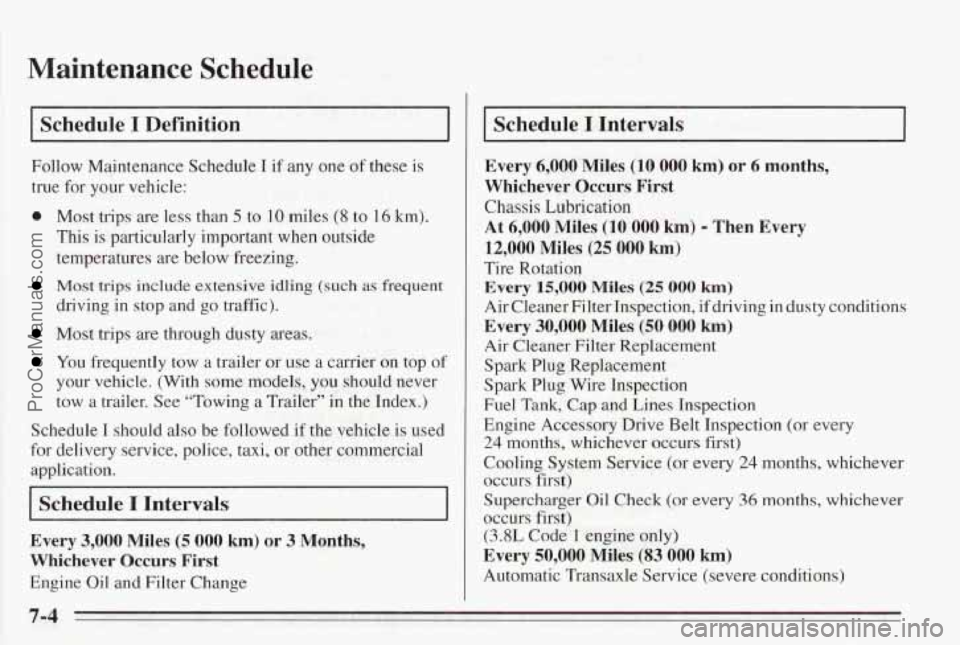
Maintenance Schedule
Schedule I Definition
Follow Maintenance Schedule I if any one of these is
true for your vehicle:
e Most trips are less than 5 to 10 miles (8 to 16 km).
This is particularly important when outside
temperatures are below freezing.
driving in stop and go traffic).
Most trips are through dusty areas.
You frequently tow a trailer or use a carrier on top of
your vehicle. (With some models,
you should never
tow a trailer. See “Towing a Trailer” in the Index.)
Schedule
I should also be followed if the vehicle is used
for delivery service, police, taxi, or other commercial
application.
Most trips include extensive idling (such as frequent
Schedule I Intervals
Every 3,000 Miles (5 000 km) or 3 Months,
Whichever Occurs First
Engine Oil and Filter Change
Schedule I Intervals
Every 6,000 Miles (10 000 km) or 6 months,
Whichever Occurs First
Chassis Lubrication
At 6,0010 Miles (10 000 km) - Then Every
12,000 Miles (25 000 km)
Tire Rotation
Every 15,000 Miles (25 000 km)
Air Cleaner Filter Inspection, if driving in dusty conditions
Every 30,000 Miles (50 000 km)
Air Cleaner Filter Replacement
Spark Plug Replacement
Spark Plug Wire Inspection
Fuel Tank,
Cap and Lines Inspection
Engine Accessory Drive Belt Inspection (or every
24 months, whichever occurs first)
Cooling System Service (or every
24 months, whichever
occurs first)
Supercharger Oil Check
(or every 36 months, whichever
occurs first)
(3.8L Code 1 ‘engine only)
Every 50,000 Miles (83 000 km)
Automatic Transaxle Service (severe conditions)
7-4
ProCarManuals.com
Page 284 of 338
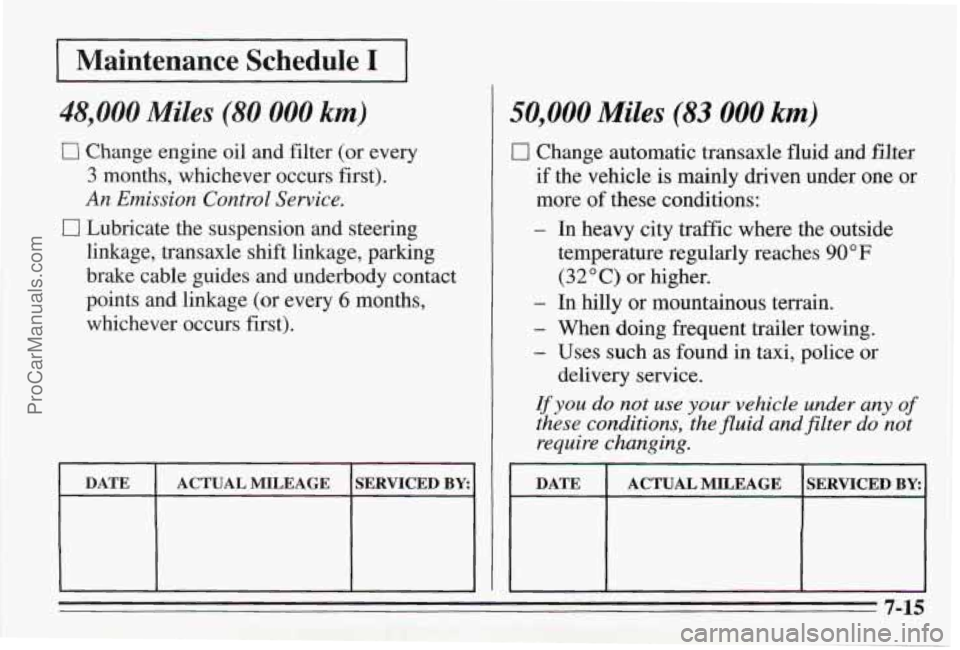
1 Maintenance Schedule I I
48,000 Miles (80 000 km)
0 Change engine oil and filter (or every
3 months, whichever occurs first).
An Emission Control Service.
0 Lubricate the suspension and steering
linkage, transaxle shift linkage, parking
brake cable guides and underbody contact
points
and linkage (or every 6 months,
whichever occurs first).
DATE
SERVICED BY ACTUAL MILEAGE
50,000 Miles (83 000 km)
0 Change automatic transaxle fluid and filter
if the vehicle is mainly driven under one or
more
of these conditions:
- In heavy city traffic where the outside
temperature regularly reaches
90 OF
(32°C) or higher.
- In hilly or mountainous terrain.
- When doing frequent trailer towing.
- Uses such as found in taxi, police or
delivery service.
If you do not use your vehicle under any of
these conditions, the fluid and filter do not
require changing.
I DATE I ACTUAL MILEAGE ISERVICED BXI
7-15
ProCarManuals.com